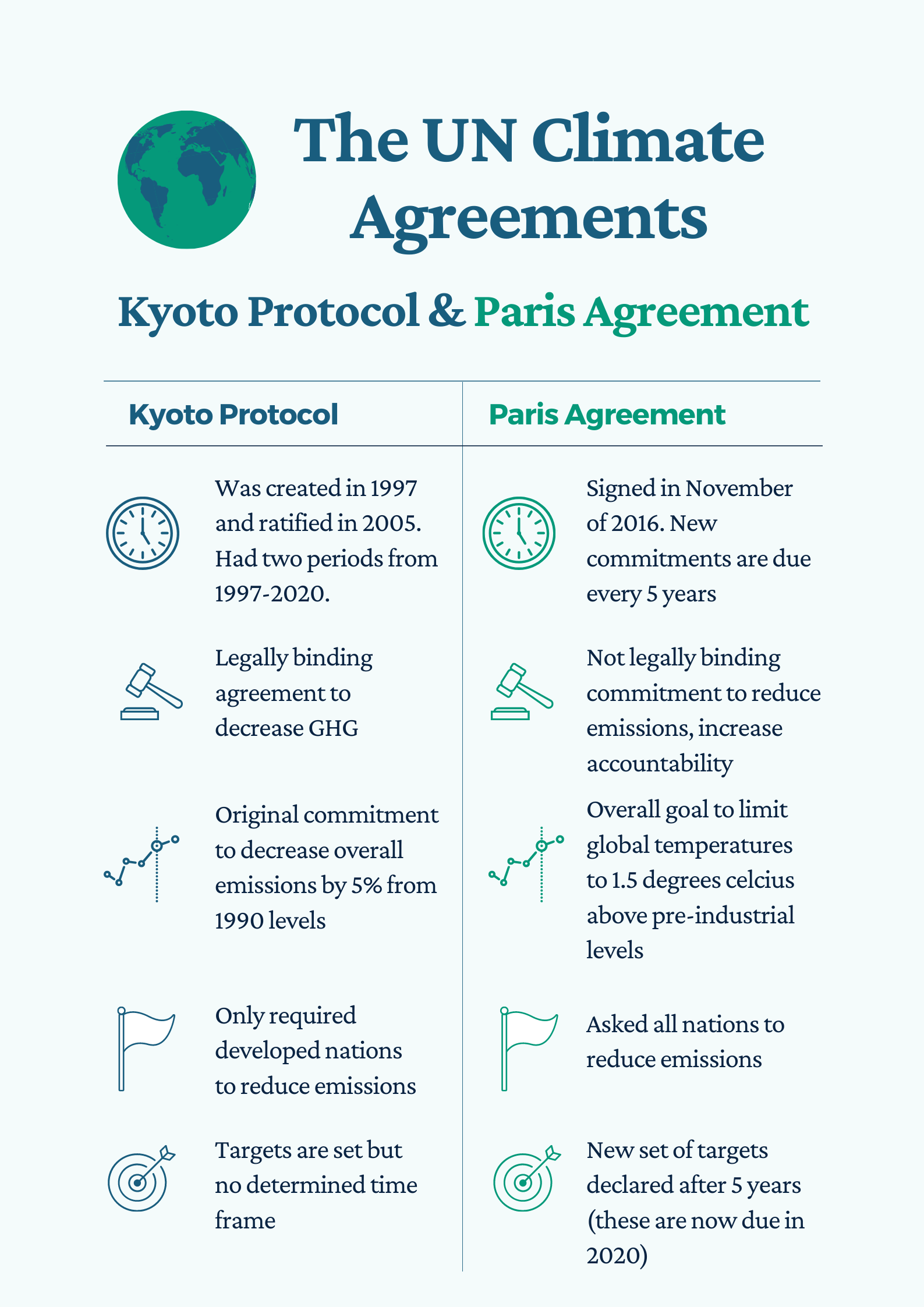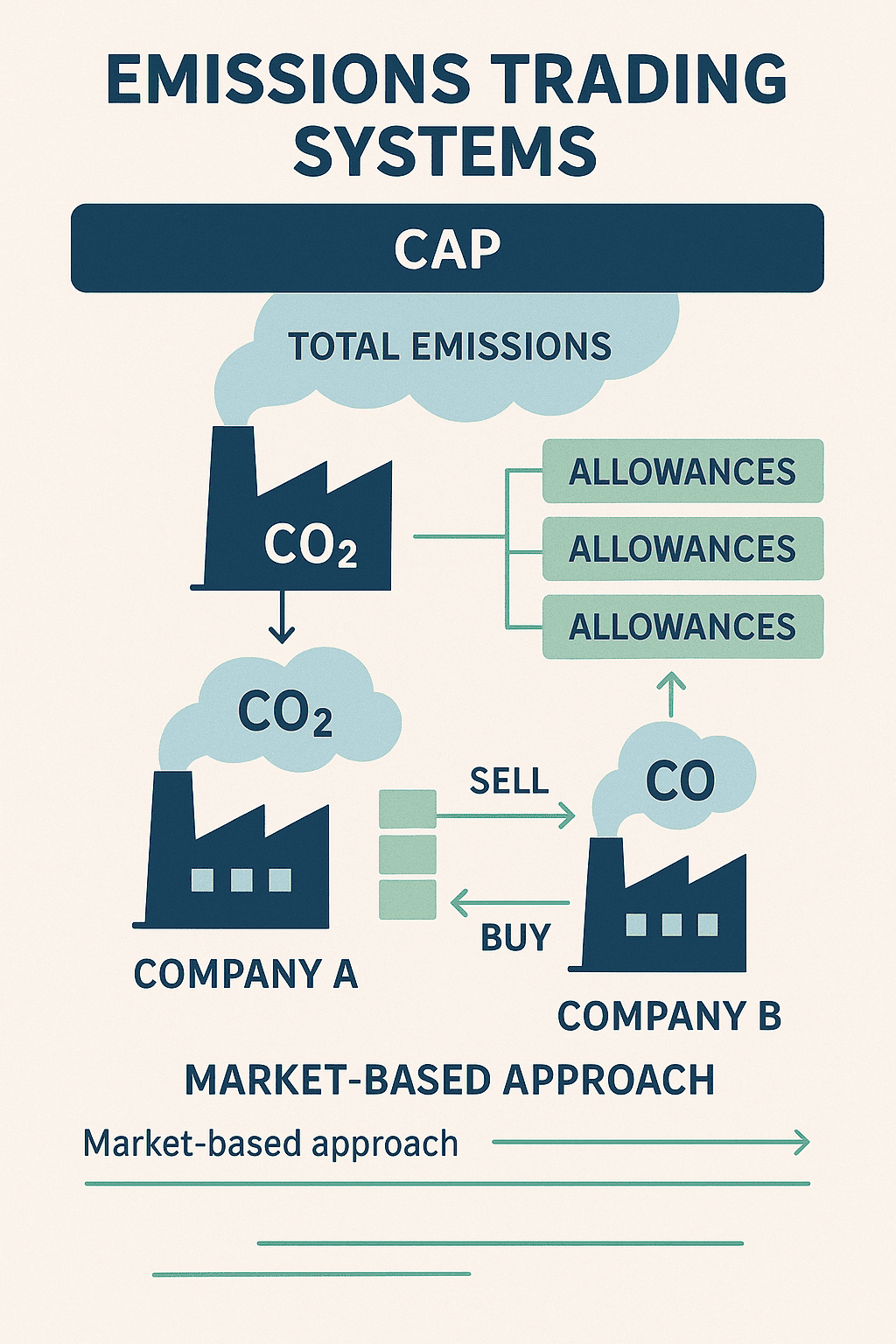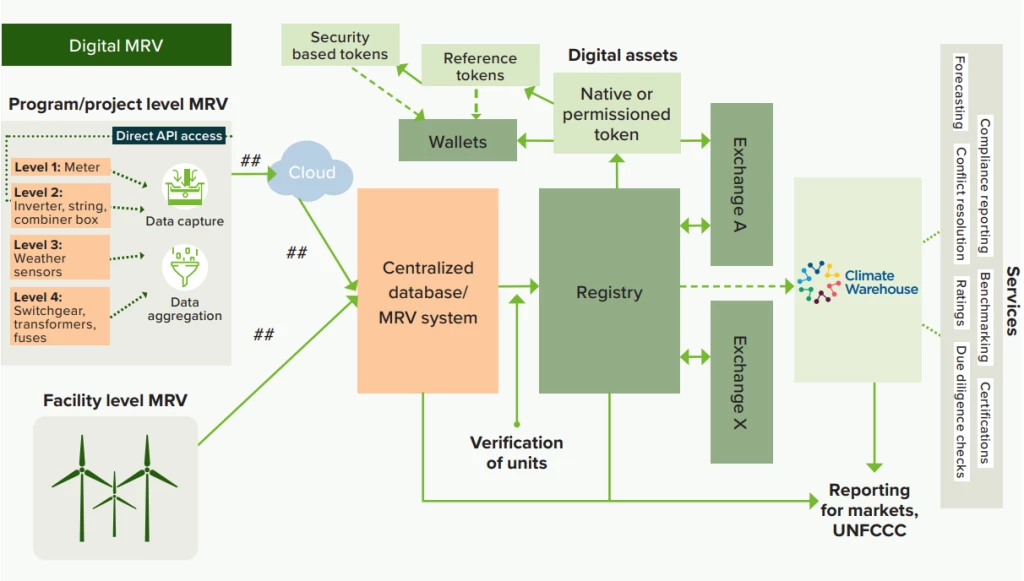Table of Contents
- Introduction 📜
- 1. From Kyoto to Paris: The Road to Carbon Markets
- 2. Carbon Markets: A Central Mechanism for Emission Reduction
- 3. The Carbon Credit Dilemma: Quality, Credibility, and Controversy
- 4. Quality Carbon Credits and Types
- 5. Digital MRV: The Future Backbone of Carbon Credit Integrity
- 6. The EU’s 2040 Climate Law Proposal: 90% Emissions Cut by 2040
- Closing Thoughts 💭
- Frequently Asked Questions ❓
- Sources and Further Reading 💡
⚠️ When shopping for books on carbon markets and credits, we strongly recommend checking out Amazon's daily deals for potential savings. These promotions often change, so reviewing them before purchasing can help you find the best price on the right model. Make sure you don't miss out!
📌 This post may contain affiliate links, so we may receive compensation if you purchase products linked to below. As an Amazon Associate, I earn from qualifying purchases. This helps support our work and allows us to create more helpful content for you at no additional cost to you. Read our disclosure for more information.
Introduction 📜
As the urgency to address the climate crisis intensifies, a range of tools have emerged to accelerate global decarbonisation. Among them, carbon credits—a market-based mechanism allowing organisations to compensate for their greenhouse gas (GHG) emissions—have attracted both significant investment and intense scrutiny. Frequently dismissed as a form of greenwashing, carbon credits have been criticised for enabling polluters to delay real emission reductions, distorting climate policy, and exacerbating social inequities (Cheong, 2025).
Yet carbon markets, both compliance-based and voluntary, continue to expand rapidly, aligning with evolving climate policy frameworks such as the EU Emissions Trading System (EU ETS) and Article 6 of the Paris Agreement. With increased private sector engagement, improving regulatory oversight, and growing demand for high-integrity credits, the landscape is shifting.
In this article, we explore how carbon credits, when designed and implemented with clear standards, robust Monitoring, Reporting, and Verification (MRV) systems, and advanced digital technologies such as satellite monitoring, AI-driven analysis, blockchain for transparency, and IoT sensors, can serve as a measurable, traceable, and verifiable tool for climate mitigation.
Furthermore, with enhanced policy support, strengthened governance, and a move toward additionality, permanence, and co-benefits, carbon credits can evolve into a legitimate and effective instrument to support global net-zero goals and unlock climate finance, especially in the Global South.
In short, provided carbon credits are measurable, traceable, and verifiable, receive policy backing for continual improvement, and integrate AI and data-driven techniques to enhance legitimacy and precision, while acknowledging their current limitations and risks, they can become a valuable—though not standalone—asset in the fight against climate change.
1. From Kyoto to Paris: The Road to Carbon Markets
1.1 The Kyoto Protocol: The First Step in Global Climate Action
Modern carbon markets originated with the Kyoto Protocol, adopted in 1997 and enforced in 2005. This landmark treaty was the first legally binding commitment by developed countries to reduce greenhouse gas (GHG) emissions, recognising their historic responsibility for climate change. It introduced market-based tools like Emissions Trading, Joint Implementation (JI), and the Clean Development Mechanism (CDM). The CDM was the most impactful, enabling industrialised nations to invest in emission-reduction projects in developing countries in exchange for certified emission reduction (CER) credits. This incentivised the modernisation of energy systems in the Global South, often supporting renewables, energy efficiency, and forestry projects, fostering global cooperation and cost-effective climate action.
1.2 Limitations of the Kyoto Framework
Despite its pioneering nature, the Kyoto Protocol had significant shortcomings. It imposed emission targets only on developed countries, leaving major emitters like the United States (which never ratified the treaty) and China (then classified as a developing country) exempt from binding obligations. This limited its global effectiveness, as the bulk of rising emissions during the 2000s came from rapidly developing economies. Moreover, enforcement mechanisms were weak, and targets were relatively modest. The lack of political consensus, combined with concerns over economic competitiveness, led to underwhelming overall results. These issues highlighted the need for a more inclusive and adaptable global climate framework.

The Kyoto Protocol and Paris Agreement shaped carbon credit markets by defining how nations reduce emissions through binding and voluntary commitments
Source: Care About Climate
1.3 The Paris Agreement: A Turning Point
The Paris Agreement, adopted in 2015 under the United Nations Framework Convention on Climate Change (UNFCCC), marked a decisive evolution in global climate governance. Crucially, it brought all countries, developed and developing alike, into a unified commitment to limit global warming to well below 2°C, while pursuing efforts to cap it at 1.5°C.
Unlike Kyoto, the Paris Agreement relies on nationally determined contributions (NDCs), where each country sets its own targets, subject to regular review and increasing ambition over time. While not legally binding in terms of specific emissions reductions, the framework emphasises transparency, peer pressure, and multilateral accountability.
Additionally, Paris created the Article 6 mechanism to regulate international carbon trading, replacing the CDM. Article 6.2 and 6.4 establish voluntary cooperation between countries and a new crediting system that emphasises environmental integrity, sustainable development, and corresponding adjustments to avoid double counting.
“Unlike Kyoto, the Paris Agreement relies on nationally determined contributions (NDCs), where each country sets its own targets, subject to regular review and increasing ambition over time. While not legally binding in terms of specific emissions reductions, the framework emphasises transparency, peer pressure, and multilateral accountability.”
2. Carbon Markets: A Central Mechanism for Emission Reduction
Carbon markets emerged from these frameworks as core instruments for achieving emissions reductions. They offer a flexible, cost-effective approach by allowing countries or entities to trade carbon credits, essentially monetising the cost of polluting and creating incentives for cleaner practices. As global awareness and climate commitments increase, carbon markets have become deeply embedded in corporate and governmental strategies. Major events like the Olympic Games, multinational corporations, and even municipalities now utilise carbon credits to offset emissions, often as part of net-zero pledges.
2.1 Compliance vs. Voluntary Markets
Two distinct yet interrelated carbon markets have developed:
| Market Type | Key Characteristics |
|---|---|
| Compliance Markets | Regulated by law—for example, the EU Emissions Trading System (EU ETS) or California’s cap-and-trade program. Entities are allocated or purchase a limited number of emissions allowances and can trade them. The emissions cap decreases over time to drive reductions. |
| Voluntary Carbon Markets (VCMs) | Operate independently of legal mandates. Enable businesses, NGOs, and individuals to purchase carbon credits to offset emissions on a voluntary basis. Often used to meet sustainability goals or corporate climate commitments. |
While the compliance market dwarfs the voluntary one in size—reaching $851 billion in 2021 compared to the voluntary market’s $1 billion—the latter plays a growing role in corporate social responsibility and emerging ESG (environmental, social, and governance) strategies.
2.2 How Emissions Trading Systems Work
In emissions trading systems (ETS), governments set a cap on total emissions allowed for covered sectors. Companies receive or buy allowances and must surrender one for each tonne of CO₂ they emit. Those that reduce emissions more efficiently can sell their excess allowances, while others must purchase additional credits. This market-based approach promotes innovation and efficiency by rewarding lower emitters.

How EU emissions trading work
2.3 Global Expansion of ETSs
As of 2025, 25 operational ETSs span jurisdictions covering over 17% of global emissions and more than half of global GDP. Notable systems include:
- The EU ETS: The largest and most established carbon market.
- The Western Climate Initiative: Linking California and Québec.
- The Regional Greenhouse Gas Initiative (RGGI): In the northeastern US.
New systems continue to emerge, particularly in Latin America and Asia, as governments recognise the dual benefits of emissions reductions and revenue generation.
2.4 Investor Interest and Financial Valuation
Carbon markets are no longer just a climate policy tool—they’re increasingly viewed as a financial asset class. Investment vehicles such as carbon ETFs and offset-backed securities are attracting institutional interest. Carbon credits are now valued using models similar to other financial instruments, factoring in discount rates, price volatility, and regulatory risk. This financialisation brings scale and liquidity but also raises questions about speculation, price manipulation, and the true environmental value of credits.
2.5 Catalysts Behind Market Growth
Several powerful trends are accelerating the expansion of carbon markets:
- Stronger regulations: Particularly around emissions reporting and offset integrity.
- Digital MRV technologies: Such as AI-driven analytics, satellite imagery, and blockchain, which enhance transparency and precision.
- Investor activism: With shareholders demanding credible climate action from firms.
- Policy momentum: Including EU proposals to integrate international credits under Article 6 and align them with national climate targets (more recently the EU’s 2040 targets).
These factors are transforming carbon markets from a fragmented, often opaque system into a more regulated, digitised, and globally integrated tool for climate finance.
3. The Carbon Credit Dilemma: Quality, Credibility, and Controversy
Despite their growing prominence in climate policy and corporate sustainability, carbon credits remain a highly polarising tool. A new meta-study published in Nature Communications (Probst & Schneider, 2025) delivers a stark warning: the vast majority of carbon credits may not represent real, additional, or permanent emission reductions. After systematically analysing over 60 empirical studies, the researchers found that only 16% of carbon credits examined reflected genuine emission reductions. The rest were either overestimated or based on activities that would have occurred regardless of credit funding. In particular, wind energy projects and improved forest management schemes—two dominant project types—were singled out for failing the crucial test of additionality. In many cases, projects received funding for activities that had already been planned or were already underway without carbon finance, casting doubt on their climate value. This widespread integrity gap underscores a critical challenge for carbon markets: ensuring that offsets do not become a license to pollute, but instead drive meaningful climate action.
3.1 Rebuilding Trust Through Reform and Standards
In response, experts such as Dr. Benedict Probst and Dr. Lambert Schneider advocate for stricter rules, enhanced quantification methods, and robust third-party verification. They argue that carbon credit projects must:
- Deliver verifiable, long-term climate benefits
- Prioritise additionality and permanence
- Protect local communities and ecosystems
- Be transparent, traceable, and independently audited
Without such reforms, carbon markets risk enabling corporate and national actors to delay the systemic changes required to reach net zero—failing both the science and ethics of climate action.
3.2 Pricing Carbon Credits: The Hidden Complexity
Contrary to the simple notion that one carbon credit equals one tonne of CO₂ equivalent (CO₂e), the actual value of a carbon credit varies greatly based on several factors:
- Project type and quality
- Co-benefits, such as biodiversity or health improvements
- Location and governance strength
- Market dynamics (supply, demand, and regulation)
The Gold Standard (2023) outlines three main pricing models:
| Pricing Model | Definition | Key Considerations |
|---|---|---|
| Market-Based Pricing | Driven by supply and demand. | Often results in lower prices, but can compromise quality due to competitive pressures (“race to the bottom”). |
| Cost-Based Pricing | Based on the actual cost of delivering a project, including fair-trade premiums. |
|
| Value-Based Pricing | Reflects not just carbon value but also co-benefits such as social and environmental impacts. |
Aligns with the social cost of carbon ($11–$212/tonne, U.S. EPA, 2023). Encourages investment in high-impact, community-oriented projects. |
3.3 Innovation and Corporate Leadership
In an attempt to guide internal investment decisions, some companies are developing internal carbon pricing models:
- Microsoft: Imposes a carbon fee on its business units to fund carbon removal and offsetting.
- Coop Switzerland: Applies an internal price of CHF 150/tonne to prioritise high-impact mitigation efforts.
Such practices send strong internal price signals and help channel capital toward higher-integrity, future-aligned projects—especially in a market still mired in inconsistency and reputational risk.
3.4 What Really Drives Carbon Credit Prices?
Understanding carbon credit pricing goes beyond simple supply and demand. Several key factors influence market value:
- Technology Type: Technology-based credits, such as Direct Air Capture, command higher prices due to significant infrastructure costs and long-term permanence.
- Certification: Projects certified by recognised standards like Verra or Gold Standard typically carry greater credibility and higher market value.
- Political Stability: Credits from countries with strong governance and legal certainty reduce investment risks and often fetch better prices.
- Sales Models: Spot trades offer immediate credit delivery, while forward contracts secure future credits, each carrying different risk profiles that affect pricing.
3.4 A Fragile Market at a Critical Juncture
As highlighted during COP29 in Baku (Greenfield, 2024), the promise of carbon markets is matched by their peril. Past scandals—from worthless forestry credits to human rights violations—have raised serious concerns about market transparency, ethics, and effectiveness. Critics, including newspapers and academic researchers, warn that carbon credits may enable governments or companies to “claim progress without real change,” risking the integrity of the Paris Agreement itself. Others argue that while markets are improving, their governance still lags behind the ambition required. However, advancements in satellite monitoring, blockchain verification, and AI-driven MRV systems (monitoring, reporting, and verification) offer hope. These tools can reduce fraud, improve transparency, and help separate legitimate projects from greenwashed claims.
4. Quality Carbon Credits and Types
4.1 What Makes a High-Quality Carbon Credit?
- Additionality: The project must exist solely because of carbon funding. If it would have occurred anyway, the credit does not represent a true emissions reduction.
- Robust Quantification: Emissions reductions must be measured accurately and transparently, using credible baselines and verified by independent third parties to avoid inflated claims.
- Leakage: The project should not simply displace emissions elsewhere; unintended increases outside the project boundary must be avoided.
- Permanence: Carbon savings should be long-term, ideally lasting 100 years or more. Buffer pools and risk mitigation are essential, especially for nature-based projects vulnerable to reversal.
- No Double Counting: Credits must be unique and not claimed by multiple parties. Transparent registries are crucial to ensuring exclusivity and traceability.
- Vintage: Newer projects often follow stricter standards, reflecting evolving best practices and improved methodologies.
Beyond carbon, the best credits also deliver “beyond carbon” co-benefits such as job creation, gender equality, and cleaner air. For example, Infosys’ cookstove project created over 2,400 jobs and significantly reduced indoor air pollution.
While carbon credits face limitations, loopholes, and ongoing scrutiny, they are evolving rapidly through reform and technological innovation. When grounded in science-based standards, supported by strong policies, and implemented with transparency and equity, carbon markets can play a vital role in driving climate action—particularly in sectors where emissions are hardest to eliminate. However, credits must complement, not replace, deep decarbonisation. Only with rigorous monitoring, reporting, and verification (MRV), genuine additionality, and a commitment to justice can carbon credits transition from a controversial stopgap to a trusted climate finance tool.
4.2 Types of Carbon Credits and Their Roles
Carbon credits can be broadly categorised into three types, each serving distinct functions in climate mitigation strategies:
- Removal Credits: These credits come from actively capturing and storing CO₂ from the atmosphere, making them crucial for neutralising emissions that are difficult to eliminate otherwise. Although they currently represent a small share of the market, removal credits are vital for long-term climate goals. Examples include Direct Air Capture and Storage (DACCS), afforestation and reforestation projects, and emerging ocean-based carbon removal techniques.
- Reduction Credits: These credits are generated by directly reducing emissions through efficiency improvements, adoption of cleaner technologies, or switching to renewable energy sources. For instance, replacing fossil fuel power with solar or wind energy generates reduction credits.
- Avoidance Credits: Focused on preventing emissions that would otherwise occur, avoidance credits support activities like forest conservation and the deployment of clean cookstoves. These projects prevent CO₂ release by protecting carbon sinks or reducing reliance on polluting practices.
No matter the credit, each one contributes uniquely to tackling climate change. While removal credits are indispensable for durable, long-term mitigation, a balanced portfolio of removal, reduction, and avoidance credits allows organisations to manage both present emissions and future climate risks effectively.
4.3 Why Forest Carbon Credits Matter Increasingly
Forest carbon credits are increasingly prioritised because they fund vital nature-based solutions that deliver carbon sequestration while supporting biodiversity and local communities. Their credibility is strengthened by emerging quality standards like the Core Carbon Principles from IC-VCM, which promote prioritising emission reductions before offsetting. Technological advances—such as satellites, drones, and blockchain—improve transparency and verification. Additionally, jurisdictional REDD+ approaches help manage risks like over-crediting by addressing emissions at the territorial level. Despite ongoing challenges, forest carbon credits remain essential for driving climate finance and fostering sustainable development.
4.4 Ensuring Market Integrity: The Need for Clearer Rules and Stronger Oversight
While forest carbon credits are gaining prominence due to their environmental and social benefits, their growing role also highlights the urgent need for clear governance and rigorous standards across all carbon markets. Without strong enforcement and transparency, the risk of greenwashing and ineffective offsets threatens to undermine progress. This calls for robust rules that ensure credits—whether from nature-based solutions or technology-driven removals—are real, additional, permanent, and socially responsible. Only with these safeguards can carbon markets fulfil their potential as trustworthy tools for global decarbonisation.
4.5 The Risks and Misconceptions of Offsetting
Carbon offsetting is not a silver bullet. When misused, it risks delaying genuine climate action. Many companies rely on offsets to claim “carbon neutrality” while continuing to emit, often without making meaningful operational changes. The common tonne-for-tonne logic—where one tonne of CO₂ emitted is ‘balanced’ by one avoided or removed—oversimplifies complex climate dynamics. This is particularly problematic with impermanent nature-based solutions, which may not guarantee long-term carbon storage. Low-quality offsets have been central to accusations of greenwashing, especially in sectors like aviation, oil, and gas. These credits often lack additionality or permanence but are still used to enhance environmental claims.
4.6 Reframing Carbon Credits as Climate Contributions
Instead of acting as a ‘licence to pollute’, carbon credits should be regarded as climate contributions that support broader global decarbonisation efforts rather than cancelling out emissions. Implementing a strong internal carbon price encourages companies to invest in higher-impact projects, ideally those that provide clear environmental and social co-benefits. This shifts offsetting from a defensive tactic to a proactive climate tool. Meaningful inclusion of the Global South is equally vital, as many offset projects are based there. Community-led governance and equitable benefit sharing are essential to ensure fairness and avoid exploitation.
5. Digital MRV: The Future Backbone of Carbon Credit Integrity
As demand for high-quality, verifiable carbon credits grows, traditional Monitoring, Reporting, and Verification (MRV) processes are increasingly seen as outdated, costly, and prone to human error. This is where Digital MRV (dMRV)—leveraging satellites, IoT devices, machine learning, and blockchain technology—emerges as a transformative solution for carbon market transparency and climate finance innovation.
Unlike manual audits and paper-heavy protocols, dMRV enables real-time, high-resolution data collection, offering an unprecedented level of precision and transparency. From tracking forest cover changes via satellites to measuring methane emissions with remote sensors, dMRV radically improves accuracy and scalability—especially for projects in remote or vulnerable regions previously excluded from carbon finance.
Crucially, dMRV enhances market trust and transparency. By using blockchain for tamper-proof, time-stamped reporting, data becomes publicly verifiable and fraud-resistant. This transparency reduces information asymmetry, supports stronger governance, and attracts institutional investors wary of opaque offset schemes.
Beyond carbon, dMRV can measure co-benefits like biodiversity, water retention, or soil health—paving the way for multi-benefit carbon credits that reflect a project’s full environmental value. By reducing transaction costs and automating reporting, it also lowers barriers to entry, making carbon finance more accessible to smaller, community-led initiatives.
In short, dMRV isn’t just a tech upgrade—it’s essential infrastructure for scaling legitimate carbon markets. By aligning monitoring with policy expectations and buyer demands, it helps ensure that carbon pricing reflects real-world climate impact—bringing integrity, efficiency, and innovation to the heart of climate finance.
6. The EU’s 2040 Climate Law Proposal: 90% Emissions Cut by 2040
While forest carbon credits are gaining prominence due to their environmental and social benefits, their growing role also highlights the urgent need for clear governance and rigorous standards across all carbon markets. Without strong enforcement and transparency, the risk of greenwashing and ineffective offsets threatens to undermine progress.
This calls for robust rules that ensure credits—whether from nature-based solutions or technology-driven removals—are real, additional, permanent, and socially responsible. Only with these safeguards can carbon markets fulfil their potential as trustworthy tools for global decarbonisation.
As the carbon market grows more complex, innovations like digital Monitoring, Reporting, and Verification (dMRV) are crucial to restoring trust and transparency, ensuring carbon credits deliver real climate benefits. Complementing these technological advances, policy makers are also stepping up.
The European Commission’s recent 2040 Climate Law proposal sets one of the world’s most ambitious targets—a legally binding 90% cut in net greenhouse gas emissions—signalling a new era of stringent regulation and market evolution that will reshape carbon pricing and demand at a global scale.
This sets the EU on one of the world’s most ambitious climate trajectories—while laying crucial groundwork for reaching climate neutrality by 2050. Anchored in broader strategies like the Clean Industrial Deal and the Affordable Energy Plan, the proposal blends ambition with pragmatic flexibility.
Carbon removals will now be formally included within the EU Emissions Trading System (ETS), and companies may use a limited share of high-quality international carbon credits after 2036—signalling a new phase in the integration of carbon markets into EU climate law.
This policy evolution carries major implications for global carbon markets. Under the proposal, the EU could become the world’s largest buyer of UN-recognised carbon credits by 2050, with demand projections nearing 1 billion tonnes of CO₂e (Green Earth, 2024). Such large-scale demand—restricted to only high-quality, Article 6-compliant credits—sends a clear signal to credit developers, verifiers, and investors worldwide.
Beyond numbers, the proposal underscores a shift toward quality-first climate finance. Early credit banking is disallowed, and any offsets must meet rigorous standards—such as Verra or Gold Standard—with documented co-benefits.
By creating a separate, transparent credit procurement mechanism outside the EU ETS, the bloc also aims to avoid market disruption while strengthening global trust.
Crucially, this sets the tone for the EU’s updated Nationally Determined Contribution (NDC) ahead of COP30 in Brazil. It positions the EU not just as a climate regulator, but as a market-shaping force, encouraging the convergence of voluntary and compliance carbon markets under stronger governance and clearer rules.
Closing Thoughts 💭
In this article, we explored the complex realities of carbon credits—from their potential to support climate action to the serious challenges around quality, credibility, and governance. We saw how most credits today fall short of representing real, additional, and permanent emission reductions, highlighting the urgent need for reform.
We also examined how stricter standards, advanced monitoring technologies, and stronger policy frameworks like the EU’s 2040 Climate Law are setting the stage for more reliable and transparent carbon markets. We emphasised the importance of prioritising credits that deliver verifiable climate benefits, protect communities, and promote social equity.
While carbon credits are no silver bullet, in this article we argued that they remain a vital part of the climate finance toolkit, especially for addressing emissions that are difficult to eliminate. However, we must insist that carbon credits ‘complement’ deep decarbonisation efforts rather than ‘replace’ them.
Ultimately, the question is whether we are ready to hold carbon markets and ourselves to the highest standards necessary to ensure these credits drive real climate progress. If we do, carbon credits can evolve from a controversial and flawed system into a trusted, effective mechanism to accelerate global climate action. But achieving this will require time, effort, and decisive action from all stakeholders committed to genuine climate progress.
FAQs❓
1. How To Improve Carbon Credits?
+Improving carbon credits involves enhancing transparency, standardizing measurement frameworks (MRV), ensuring additionality, and using blockchain or digital registries for traceability.
2. What Are The Quality Criteria For Carbon Credits?
+Quality carbon credits must meet criteria such as additionality, permanence, verifiability, no double-counting, and positive social/environmental impact.
3. What Makes A Good Carbon Credit?
+A good carbon credit represents a genuine, measurable, and permanent reduction in emissions, verified by an independent third party, and clearly documented.
4. Which Of The Following Are Qualities Of A High Quality Carbon Offset Project?
+High quality projects are additional, permanent, independently verified, transparent, and contribute to sustainable development goals (SDGs).
5. What Three Conditions Must Be Met For Carbon Offsets To Be Credible?
+Credible offsets must be additional, measurable, and permanent—with robust third-party verification and clear documentation.
6. Why Do We Need Carbon Credits?
+Carbon credits provide a market-driven approach to reduce greenhouse gas emissions and finance climate-positive projects globally.
7. What Are The Positives Of Carbon Credits?
+Carbon credits encourage emission reductions, fund sustainable projects, support green innovation, and offer flexibility for hard-to-abate sectors.
8. What Are Three Reasons Why Carbon Is Important?
+Carbon is essential to life, regulates global temperatures through the carbon cycle, and plays a central role in climate change mitigation.
9. What Is The Primary Purpose Of Carbon Credit Accounting?
+Carbon credit accounting ensures emissions are accurately tracked, reported, and offset, maintaining environmental integrity and compliance.
10. How Do Carbon Credits Actually Work?
+Each credit represents one ton of CO₂ reduced or removed. Companies buy credits to offset their emissions, funding climate-positive projects worldwide.
11. How Does The Carbon Credit Scheme Work?
+Governments or voluntary programs certify projects that reduce emissions. These generate credits, which are sold to emitters to offset their carbon footprint.
12. How To Benefit From Carbon Credits?
+Individuals or businesses can benefit by generating credits through climate projects or reducing their emissions to participate in carbon markets.
13. What Is The Primary Purpose Of Carbon Credits?
+Their main goal is to reduce global emissions cost-effectively and fund verified climate action efforts where they're needed most.
14. Where Do Carbon Credits Go?
+After purchase, carbon credits are retired in registries, proving the emissions have been offset and can't be reused or resold.
15. Where Can Carbon Credits Be Sold?
+Credits can be sold via compliance markets (e.g. EU ETS), voluntary exchanges (e.g. Verra, Gold Standard), or directly to companies seeking offsets.
16. Which Country Has The Most Carbon Credits?
+Brazil, India, and China have historically generated the most credits due to large renewable and forest-based projects under global standards.
17. What Is The Main Source Of Carbon Credits?
+Sources include renewable energy, forestry (REDD+), energy efficiency, methane capture, and direct air carbon capture projects.
18. When Did Carbon Credits Start?
+Carbon credits began under the Kyoto Protocol in 1997, with operational mechanisms starting in the early 2000s via the Clean Development Mechanism (CDM).
19. Where Do Carbon Credits Go?
+They are tracked in public registries and retired to prevent reuse once used for offsetting emissions by a buyer.
20. Are Carbon Credits Issued Annually?
+Yes, most projects are monitored annually, and credits are issued after verification of emission reductions over that period.
References 💡
- Cheong, B.C., 2025. The paradox and fallacy of global carbon credits: A theoretical framework for strengthening climate change mitigation strategies. Anthropocene Science. https://doi.org/10.1007/s44177-025-00084-0
- Chandler, D.L., 2024. Explained: Carbon credits – Can carbon trading systems reduce global emissions, or are they little more than greenwashing? MIT News, 28 February. Available at: https://news.mit.edu/2024/explained-carbon-credits-0228 [Accessed 28 July 2025].
- European Commission (2025) Climate Law: Commission proposes 2040 climate target to achieve climate neutrality by 2050. [online] European Commission. Available at: https://ec.europa.eu/commission/presscorner/detail/en/ip_25_1687 [Accessed 28 Jul. 2025].
- Frank, S. (2023) Does carbon offsetting do more harm than good? Carbon Market Watch, 6 July. Available at: https://carbonmarketwatch.org/2023/07/06/does-carbon-offsetting-do-more-harm-than-good/ [Accessed 27 July 2025].
- GoodZero. (n.d.). 6 reasons the world needs carbon credits. [online] Available at: https://www.goodzero.com/news/6-reasons-the-world-needs-carbon-credits [Accessed 28 Jul. 2025].
- Green Earth (2024) EU’s 2040 plan could make it the largest buyer of UN carbon credits. [online] Available at: https://www.green.earth/news/eus-2040-plan-could-make-it-the-largest-buyer-of-un-carbon-credits [Accessed 28 Jul. 2025].
- Greenfield, P., 2024. COP29: What are carbon credits and why are they so controversial? The Guardian, 10 November. Available at: https://www.theguardian.com/environment/2024/nov/10/cop29-what-are-carbon-credits-and-why-are-they-so-controversial [Accessed 28 July 2025].
- Kenton, W. (2025) ‘Carbon Credits: What They Are, How They Work, and Who Buys Them’, Investopedia, 28 January. Available at: https://www.investopedia.com/terms/c/carbon_credit.asp [Accessed 28 July 2025].
- Max-Planck-Gesellschaft, 2024. Climate Impact of Carbon Crediting Projects Is Substantially Overestimated. Available at: https://www.mpg.de/23737687/climate-impact-of-carbon-crediting-projects-substantially-overestimated [Accessed 28 July 2025].
- Offset Guide, 2023. What Makes a High-Quality Carbon Credit? [online] Available at: https://offsetguide.org/what-makes-high-quality-carbon-credits/ [Accessed 29 Jul. 2025].
- Ramesh Walsh, V. and Toffel, M.W., 2023. What Every Leader Needs to Know About Carbon Credits. Harvard Business Review, 15 Dec. Available at: https://hbr.org/2023/12/what-every-leader-needs-to-know-about-carbon-credits [Accessed 27 Jul. 2025].
- Senken (2025) Case Study: How Can dMRV Support High Quality Carbon Credits? [online] Available at: https://www.senken.io/blog/case-study-how-can-dmrv-support-high-quality-carbon-credits [Accessed 28 Jul. 2025].
- Taguchi, S., 2022. Carbon Credits: A Salient Role in Environmental Capitalism. The Head-Royce School. [online] SSRN. Available at: https://papers.ssrn.com/sol3/papers.cfm?abstract_id=4528694 [Accessed 25 Jul. 2025].
- World Economic Forum, 2023. 5 reasons to support forest carbon credits in the fight against climate change. [online] Available at: https://www.weforum.org/stories/2023/01/5-reasons-forest-carbon-credits-climate-action/ [Accessed 27 July 2025].











